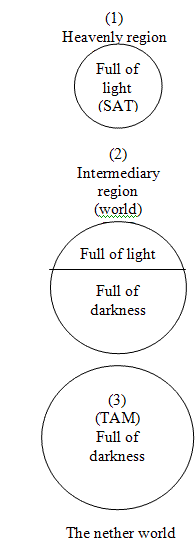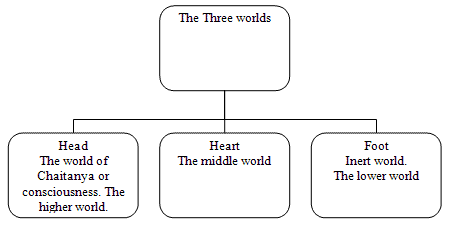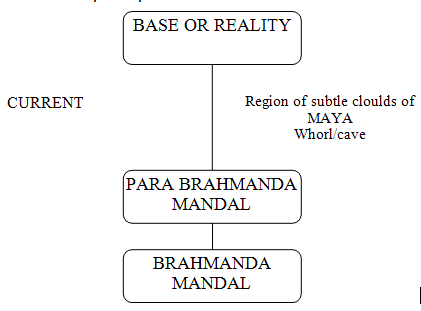Brahman
|
Brahman is described as expanding with contemplation (Bruha - expanding, and Manan - contemplating). This name has been given to It, because it is the Jiva that gives It such a name. Moreover, the Jiva has given this name from its own view point (stand point). Otherwise, It has not disclosed Its name to anybody till today, nor would it ever disclose it. Since the Jiva itself has movement, development and thinking in it, it has given It a name according to its own nature, imagining It to be greater. In fact, It is neither greater nor smaller; neither limited nor limitless. It is as It is. And this name is good from the point of view of giving it a name. All the characteristics or attributes of Brahman are subject to the mind of the individual soul, the Jiva. He is with or without attributes, Saguna or Nirguna, according to the nature of the Jiva. The Jiva fixed Brahman as the highest idea, and the supreme goal to be attained according to its own understanding. Having done so, the Jiva has desired to mould itself like-wise, and achieve progress towards the Brahman. This is the result of its intelligence. And when it evolves sufficiently in knowledge and intellect, it will come to know that all these mental attributes of the Brahman were determined by its own understanding or knowledge. It will then accept the Brahman as without attributes, discarding the idea of Saguna Brahman. The Jiva finds peace in the fullness, the perfection of the Brahman, because it thinks itself as imperfect and incomplete, and loves flawlessness and perfection. This is the first point. Secondly, according to the Jiva the whole universe and existence, that is the whole of the Brahmanda, is in rotation. The earth, the sun, the moon, the stars—all are in rotation and, as such, the Jiva also finds itself in rotation. And, since the cyclic rotation has some special purpose, it superimposes this purpose on all, and thinks all to be possessing intellect and discrimination. It thinks even the most unwise to be wise in their work, and hence there is no wonder if the Jiva thinks the Brahman also to be wise. And, when after attaining knowledge and understanding it attains peace and steadiness, it supposes Brahman also to be in the form of peace from head to heels, and becomes quiet. The existence of the Brahman is dependent on the existence of the Jiva. You exist and therefore believe in His existence, just as the drop, which keeps the ocean in view, believes and accepts the existence of the ocean. If you were not in existence, who would believe, understand and question about the existence of Brahman? The totality of the Jivas is Brahman also. This universe, Brahmanu, also is the gross body of the Brahman. From the point of view of gross body this is considered as Virat, the sum total of all existence. The intellect of the Brahman is dependent on that of man, because when man has intellect and understanding, he thinks the Brahman to be the sum total of all intellect, and calls Him omniscient and perfectly wise. Since we consider knowledge and intellect as the basic factor in us human beings, we consider Brahman also to be the sum total of all the basic factors of knowledge and intellect, and call Him the 'Internal check' or Antaryamin, 'all pervading', 'Prime mover', 'Heart of the Heart' and so on. We know happiness and joy, and become happy. We also see joy in others. From this we conclude that just as the aggregate of body-hood is seen in the form of the whole universe, even so there must be the aggregate of joy, which we call Supreme bliss, All-joy, All-happiness, Hiranyagarbha and so on. It is said that one should see the whole universe in one's own self and oneself in the universe. This is merely verbal and theoretical. Now listen to the practical thing. We see around us millions of living beings, the sun, the moon, the stars, kings, the public and innumerable other things. All these great and small scenes are caught in the pupils of our eyes within the fraction of a second. Open your eyes, and lo! thousands of stars in the sky enter into them. This is the external condition. Now, close your eyes and the same things appear inside also. The external and the internal seem to be one and the same. We think that we are the subjects of some subordinates of some officer and the creatures of stances. So, we have taken the mean idea of subordination, but we never thought even for a moment the reality of all these is dependent on us. If we were not there who would call the King a king, and the people as 'people'? When we ourselves accept a king as a king, he is a king! When we accept father as father he becomes a father! When we accept a wife, she becomes a wife! All these are accepted things, There is a proverb which says, 'if you believe in God, there is God; otherwise it is stone'. It is we, the centre, round which all these scenes of plurality revolve in such a way that we have no idea of this at all due some reason. Seeing this spinning had revolution, our intellect also began to revolve, and the result was that the joy of the polar or central conditions was taken away. It is the circumference that rotates and revolves; but seeing the circumference, the centre too believed itself as revolving, just as houses and gardens appear to be revolving to the boys who rotate in a game, and the trees and lakes appear to move to those travelling in a train. This is called illusion and, once we are under such illusion, we have to necessarily experience it revolving round and round. Let us now understand the secret of seeing or, selves in all, and all in ourselves. Imagine that we are Brahman, the centre, the original element, and the essence of existence. Let this idea be internal first. Then, looking to the external manifestation, think that all these are the symbols of our own mental feeling. All these have emerged from us are our form. What else can there be excepting ourselves? When the internal and the external become one, the veil of plurality will first drop off. One-ness comes in, and that too will vanish gradually. What will remain then? You yourselves will remain. The triad of knower, knowable and the known will disappear. It will be a strange condition which can be neither expressed, nor heard, nor thought of. Merger in one-merger in plurality and merger in Reality—all these are the interim states. 1. An ignorant boy has cast his reflection in a mirror and says that there is a boy inside the mirror. He also says that the boy should be taken out so that he may play with him. A mad dog of the mansion roams barking at his own reflection. This is the condition of wise persons who are immersed in plurality. 2. An intelligent person looking at his reflection in a mirror says that he is one and the same person inside and outside the mirror. This is the condition of merger in one-ness. 3. A lover of the condition of merger in Reality thinks the internal and external idea as one and the same and, keeping the reality of originality behind the veil of bliss, remains always blissful. This is the condition of merger in reality. These three are not in an unchanging condition. Hence the beginning of the signs of the fourth condition. The Self, which is the source of all things, seldom comes to view. In one sense It has neither name nor form, and in another sense all names and forms belong to It only. It is the support of all, and has itself no support. All are dependent on It, but It is not dependent on anybody. It is the Self and its being so (from our point of view) is Its glory. It is the absolute, and the absoluteness (from our view point) is Its attribute. We ourselves call It as Self and Perfect, these words being coined for our own understanding. They give some sort of experience about it, and we obtain peace, for It is the real peace. For example, suppose that there is a thing, underneath which Its existence in the form of ideas and subtlety surrounds It and has its play.
This existence is called illusion or Maya. With the support of that Thing, this illusion spins there and plays in the form of very subtle particles developing many forms with its reflection. This existence has no separate entity of its own. It appears to be existent and non-existent by the existence of that original thing, just as strength depends on the strong. Strength is not separate by itself, but gives the experience of its existence in connection with activities. The reflection of the Absolute or Real Self, which fell in this existence,
was caught up by that existen Another region or circle, which was a mere reflection of this existence, was formed. Since it was below That, there was all darkness in it. When a lamp burns, smoke is emitted out, which makes a place for itself after depositing there. That place also becomes black. Thus, two regions or circles are formed; one of light and the other of dark-ness. The current of the region of light flows to the region of darkness and black-ness again. In this process of the current flowing to and fro, another region is formed in the middle which resembles the middle portion of a small drum, shaped like an hour-glass. It may be called as the middle region.
These three are the lower circles of Maya, and are with attributes.
Antariksha is the middle region which shines like a star, Antar-middle, and iksha-star.
The heaven is the head or the topmost
part of the structure, and the nether world is the foot. The middle can be
understood as the heart.
The reflected current of the Real thing comes in all these three. It plays there, creating the three worlds.
Now, the creation starts from the mixture of consciousness or Chaitanya, and inert matter or Jada. The heart is like a book to understand this formation. It is a mixture of consciousness and inertness and, as such, it is capable of knowing both. There is consciousness in Sat; inert-ness or Jadatha in Tam, and effort, activity, thought and contemplation in the Raj. There is spirituality or Adhyatmiktha in Sat; body-consciousness or Shareeriktha in Tam, and the mixture of both spirituality and body-consciousness in Raj. There is the spirit, Atma, at the top. The shadow of the spirit is at the foot, which is body consciousness or shareeriktha. And in the heart (or mind) there is the condition of mixture of the spirit and its shadow. The causal body is in the Sat or the top (head); the gross body is in the Tam or the foot (lower region); and there is the subtle body in the middle or Raj. These three, having mingled with one another, work in a peculiar way. There is bliss or Anand in Sat, existence or Sat in Tam, and knowledge or Chit Jnan in Raj, the middle portion (or condition). Knowledge or consciousness, is only the name of the middle condition. The nature of Tam is action. It is the first stage of manifestation of existence, and is also awakening. The nature of Sat is mere bliss and happiness, peace and stability, which are the final condition of physical activities. It is also Sushupti. The nature of Raj is consciousness, which is the intermediate stage. It is also dream state called Swapnaavastha. In dyau the heavens, there is consciousness (Chaitanya), that is, grossness of power, of light, or manifestation which is a crystallized condition. That is why there is no knowledge in Sushupti. Knowledge is the characteristic of the heart, which is always desirous of controlling both alertness and inert-ness. When knowledge reaches the state of Sushupti it loses its position, and is drowned as soon as it comes under its (sushupti's) influence. But if it ascends there, retaining its consciousness by means of Sadhana, and is alert, it is possible to have knowledge, otherwise not. The heart is generally drowned or absorbed in the activities of the gross body, losing the knowledge of its own reality. Practice or Sadhana is that remedy which does not allow unawareness in Sushupti. Just as the mind thinks and acts in connection with the affairs of the gross body, and retains its knowledge, so also, if it can think and act tasting at the same time the bliss of sushupti or the soul (Atma), it is possible to achieve the state of awareness even there. The practice of this is the first step of upasana.
What
is this ‘we’ of ours? It is our heart. But when we have called this heart as the
subtle body, the inner structure or inner body, how can the gross body know
things and have experiences? The fact is that the region of subtle clouds of
Maya is spinning below the self or Reality. Assuming the form of a whorl, it
absorbs the reflection of Reality in itself. This peculiar, state of grossness
or frozen-ness is the state of peace, which is the beginning, middle and the
final stage of consciousness or spirituality. It is perfect and is in the seed
form. The currents that start and flow from this form a region (circle) after some
distance. They settle in the form of a bulb, and are designated as the Brahmanda
and Parabrahmanda regions. A drop of the reflection of the original condition is
found, forming three bodies; of Brahman namely the causal, the subtle and the
gross. That reflected part which is Reality dwells in three bodies, which are then
called Hiranyagarbha, Antaryami or Avyakrit, and Virat. i. That part which dwells in the whorl is Hiranyagarbha. ii. That which dwells in the Para Brahmanda Mandal is the Antaryami or
Avyakrit. iii. That which resides in the Brahmanda Mandal is the Virat Purusha. Among these the Hiranyagarbha is the causal body, the causal condition, the
state of nothingness or Shoonyabhava, the condition of peace and the
higher state of spiritual bliss. Antaryami or Avyakrit is the subtle body,
subtleness, the condition of knowledge, intellect and discrimination, and the
mental faculty, the inverted movement of the mind. Virat is the gross body,
gross body-ness, the movement of action and of body, and the true state of body-ness. The gross body of the Brahman is Virat; the causal body is Hiranyagarbha; and
the subtle body is Antaryami or Avyakrit. Virat is the body, Antaryami is the mind, and Hiranyagarbha is the soul of
the Brahman. These three the Physical or Sthoola, the astral or Sookshma, and
the Causal or Karana are the bodies of the heavenly God. There is a fourth
condition, transcending these three, which can be expressed or indicated as
non-existence, existence and super existence. This Brahman is an ocean formed
out of a drop of that fourth state. It, the ocean, always undulates, supporting
the structure of Maya (Mayavee Rachana) or the universe of attributes. It plays
this game in itself. This triad (triple) condition of Brahman is called the
Trinity. In the terminology of saints it is Trikut or Trikuti. This is the sum
total of the gross, subtle and causal conditions. It has the material, the
conscient, and the mingled condition of the knot of matter and consciousness,
which can be termed as the body-ness, as well as the Knot of spirituality — the
mixed knot of Sat, Raj and Tam. These three mingle together and are called
Brahman. What is that fourth state called? It is called Srut — attention — in
the physical plane; Sabda— sound—in the higher plane; and Asabda—non
sound— in the Real plane. But all these are names and names only. Srut can be recognised as attention, steadiness, withdrawal, peace and
stability. As the reflected form of the fourth condition or state is found in
it, it has the characteristic of being steady and motionless. Being associated
with it, this heart also is enlivened, and acts taking pride in it. And when its
current is drawn or pulled upwards it becomes actionless, lazy and dead. The word Srut is derived from Sruti which means ‘heard’. As there was no
other word which could express the sense in a better way, this word was used as
a measure of economy. By a common misunderstanding the hymns of the Vedas, the
Vedamantra, are called Sruti. Had they called the sound of the mantras as Sruti,
they would not have erred, because it is incapable of being refuted. It is a
matter of experience that everything originates from sound, and merges in the
sound.
|
|


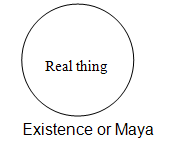
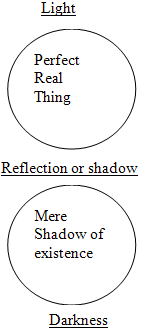 ce; and making a sphere, circle or region became
steady and stable, absorbing all the strength in the form of reflection.
ce; and making a sphere, circle or region became
steady and stable, absorbing all the strength in the form of reflection. 